It don’t run in our blood. That kind of luxe just ain’t for us.
It’s always hard to come up with a title for these posts. The “Royals” song by Lorde popped into my head and I couldn’t get it out, despite the fact that Lorde is from New Zealand and of Irish and Croatian descent rather than Scottish. The song ultimately proved more insightful than I’d anticipated, though.
My brother and his family are living in Scotland right now, so I’ve been sort of interested in trying to get a better handle on some of our Scottish ancestors. I once did a review of the hodgepodge of backgrounds in my ancestry and discovered that my siblings and I are 50% Scottish, which I was very excited about and leaned into big time. *Cue my very bad Scottish accent…* “Och, laddie…”
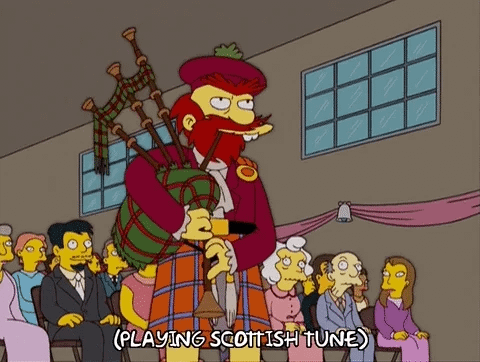
One of these Scottish ancestors I have always been curious about is my great-grandmother, Maggie Roy. The rumour in our family was that she was related to the famous Scottish rebel, Rob Roy, whom Liam Neeson played in the 1995 film of the same name. This connection seemed unlikely to me after doing a bit of digging since Rob Roy’s full name was Rob Roy MacGregor (Raibeart Ruadh MacGriogair), of the Clan MacGregor, rather than “Roy” being his last name. Some people even just wrote off the “Roy” as being a reference to his red hair rather than being an actual name at all.

I’ve since dug a bit deeper and have made some exciting discoveries.
Subscribed
Quathside Farm
Maggie Roy was born September 12, 1886 near the village of Dalry in Ayrshire, on the west side of Scotland. She is listed as having been born in Quathside, which this Ordnance Survey book from 1856 describes as “a small thatched farm house. […] Mr. John Kyle proprietor.”
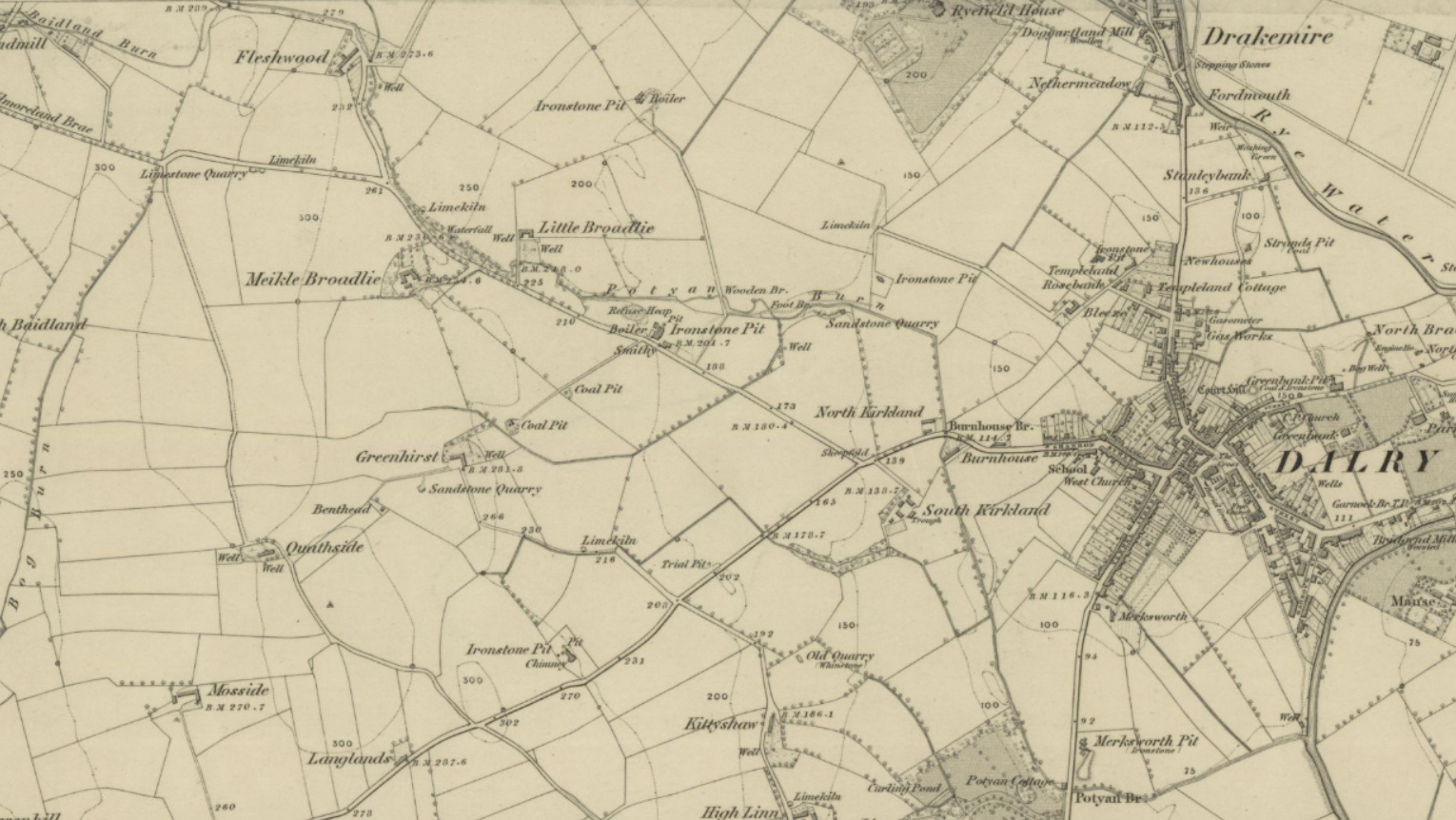
Amazingly, because of the accuracy of the above map and the constancy of the property lines in the area, it’s still possible to see Quathside on Google Maps today.
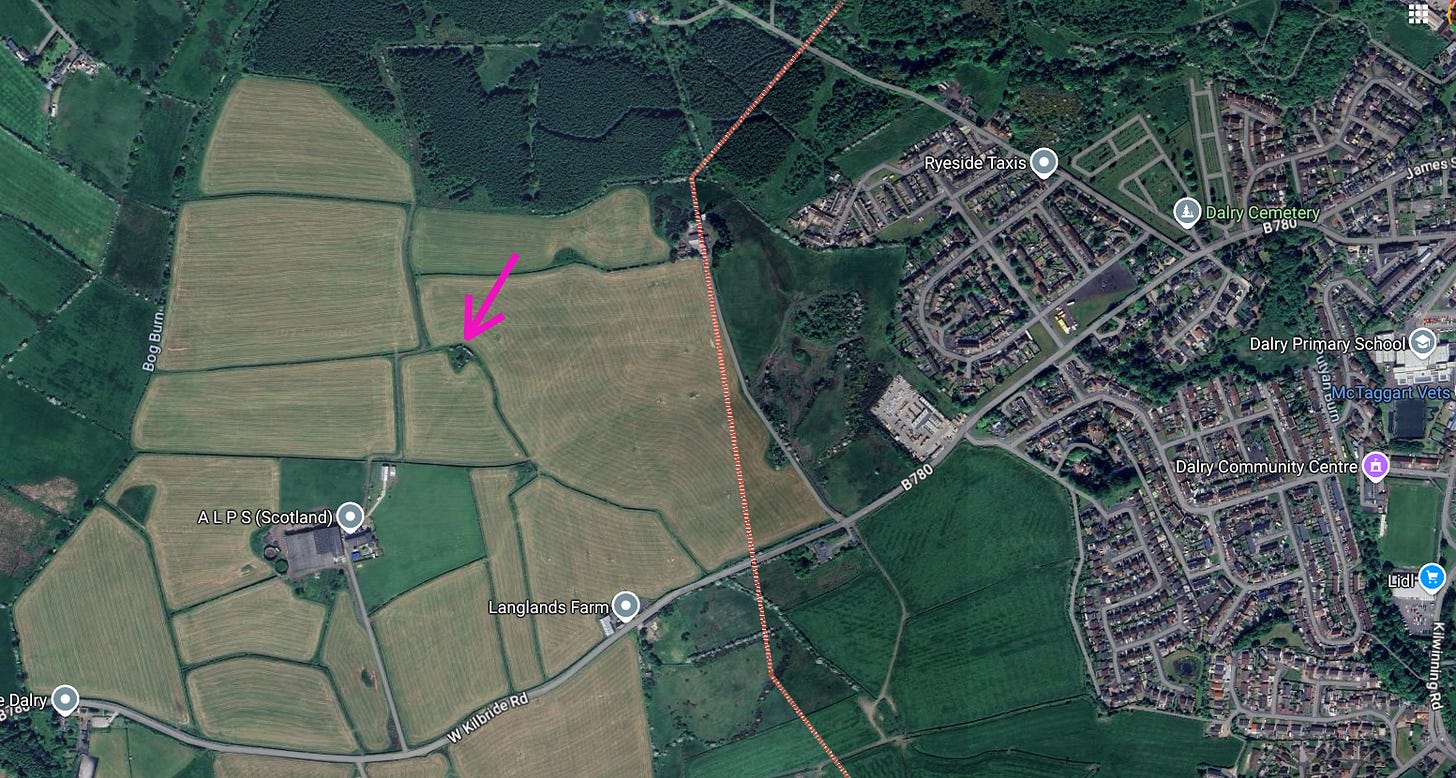
What’s listed as “Mosside” in 1856 is now ALPS (Scotland), although its address is still “Mosside Farm”. (ALPS appears to be some kind of building consultant company). Langlands in the ordnance map is still Langlands Farm. And just north of these is a farm property shaped like bloated letter R with a grassy nick in its top: Quathside Farm.

Maggie’s family had been at Quathside Farm for several years off and on before she was born. Not only had her parents been married there, but her mother’s family had been there before the marriage as Maggie’s grandfather, Charles Cranstoun, was the gameskeeper at the farm.1
Maggie’s father, William Roy, is listed as a boatbuilder in the 1881 census (6 years prior to Maggie’s birth). He’s 17 at the time and living in the seaside town of Largs, Scotland, right near the pier, with Robert and Isabella McFarlane.2 Isabella was William’s aunt (his father James Roy’s sister). At the time, Robert was a baker.
Prior to that, his family is listed as living in the Village of Dalry itself on North Street, a short street that still boasts “The Auld Hoose Tavern,” Dalry’s oldest pub, built in 1786. (William and his family almost certainly would have visited). William’s father, James, was a miner who came to the Parish of Dalry sometime around the age of 18, at which point he lived with his wife Janet at her uncle Hugh Clelland’s house in Drakenmire, a town just north of Dalry proper. The Clellands were long-time Dalry people. James Roy had been born in Inverkip, Renfrewshire, but it appears that his father, John Roy, was from Dalry originally as well. His grandfather, Andrew, was the first Roy to come to Dalry, sometime around 1792, when he married Ann Crawford. (The Crawford family whom he married into had been in the vicinity of Dalry — specifically in the area of Knockendon Farm to the northwest — since the 1600s).
William and his wife, Catherine Fraser Cranstoun, were married at Quathside near Dalry in 1886. Based on the censuses and birth locations of his children, there is some movement back and forth for William Roy between Quathside and Largs over the course of about ten years before the family finally settled further north along the Firth of Clyde in Rosneath.
Rosneath on the Gareloch
This phrase, “Rosneath on the Gareloch,” is one that I remember my mom and grandparents saying many times. You have to say it with a strong brogue. Until this very moment, while researching the article you are now reading, I did not have the faintest clue what a “gareloch” might be.
The Gare Loch is, like all lochs in Scotland, a body of water. Specifically, it’s a thin finger that juts off the northern curve of the Firth of Clyde. Rosneath is one of the many villages that dot its shore.
In the 1891 census, William and his young family are listed as living in Clachan House in Rosneath. Likely they were living in one of the small houses that were located to the south of the main house, and by 1835 also included a school on the southern edge of the property. Clachan House was destroyed in a fire in 1962. William’s occupation in Rosneath is still listed as boatbuilder — and by this time he will have had over a decade’s experience in that vocation.
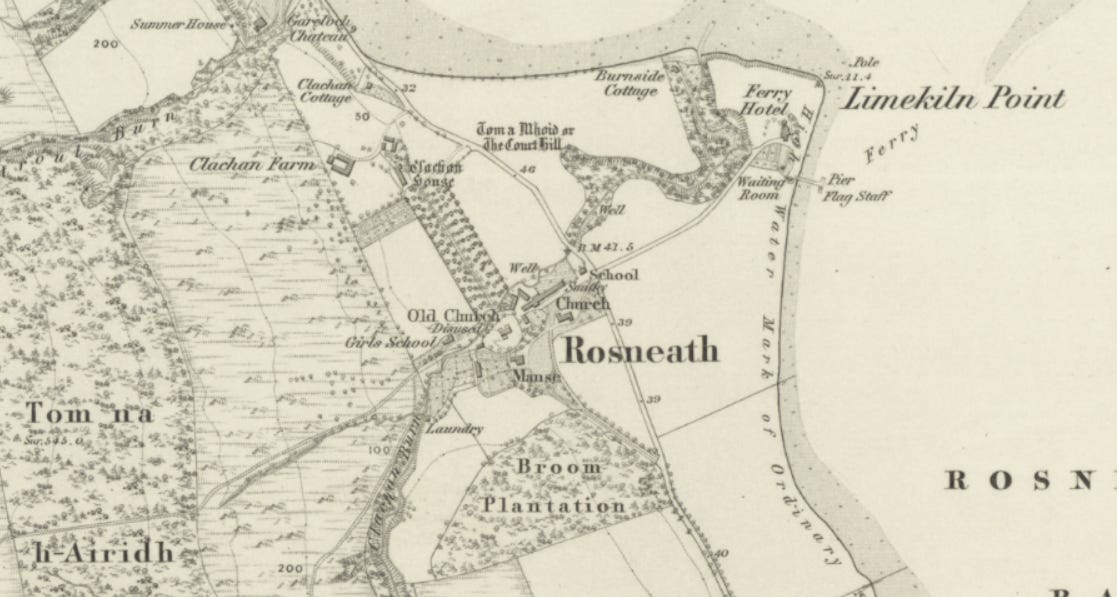
It’s a good reminder that people were moving around quite a bit during the late 1800s. I’ve always associated the Roys with Rosneath on the Gareloch, but Maggie actually didn’t arrive there until she was two and a bit. (Her younger brother James was born in Largs in 1888; her next brother Charles was born in Rosneath in 1889 as were the rest of her siblings). She seems to have lived there until she married my great-grandfather Alexander Henderson in January 1917 at the age of 30.
Okay, but is Rob Roy related?
To determine whether Maggie Roy was related to Rob Roy, it would be necessary to push the Roy genealogy backwards past the era in which Rob Roy was living: 1671-1734. Thanks to the good work of many researchers, including my Aunt Eleanor Buzzacott (technically, my first-cousin-once-removed-in-law), we have pretty good records for Maggie’s forebears going back to the 1670s.
As noted above, Andrew Roy (b. 1768) was the first Roy to arrive in Dalry. He was born in Killearn, Lanarkshire, northeast of Glasgow. Andrew’s parents, James Roy (b. 1731) and Margaret Yuill (b. 1747), were also both born in Killearn, but prior to that had come from families situated still further east, in Stirlingshire.3 (The family of Margaret’s mother, Elizabeth Buchanan, had been situated in Killearn for several generations). James’s father, John Roy was married to Elspeth Blaiketer in 1715 in Carriden, West Lothian, but was born in St. Ninian’s, Stirlingshire, Scotland.
John Roy married Mary Clark (or Clerk) on March 23, 1697 in St. Ninian’s Parish Church. About 50 years after John and Mary wed, during the failed Jacobite Rebellion of 1745, that church — which the Jacobites (loyalists to the Stuart, rather than Hanoverian, royal line) had been storing munitions in — blew up. Only the tower remained. It’s still standing today. St. Ninian’s is about a 13-hour walk from Glengyle, the birthplace of Rob Roy.
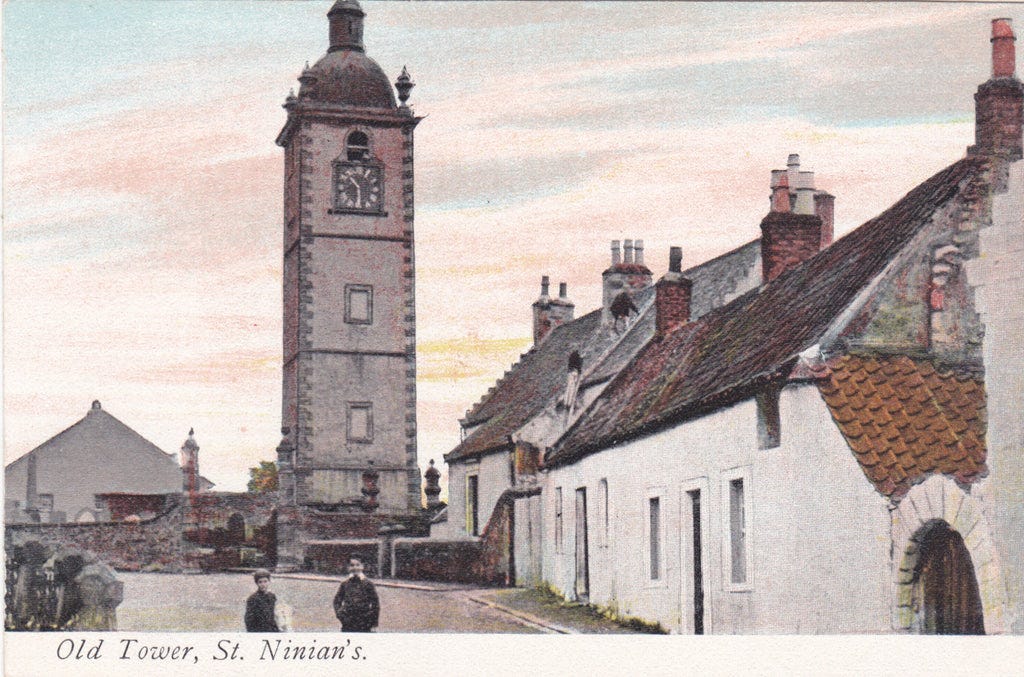
That distance — even though it’s doable — is aggravating my doubts about the whole “cousin Rob Roy” rumour. I decided to take a different approach to figuring out the question and started looking into Rob Roy’s ancestry instead.
Where did the “Roy” in his name come from, anyways? Often, people will have a matrilineal surname as a middle name. Although his paternal grandfather was the Laird of the Clan MacGregor, Rob Roy’s mother also descended from Scottish nobility. Turns out that his mother’s great-grandfather was a nobleman named Duncan Roy Campbell, 4th Laird of Glenlyon. This was not apparently an inherited middle name, but rather an epithet, meaning: “The Red.”
So… given that we’re almost 1500 words into this article and I’m still not really sure, I may have to park this question. According to this website, “Roy” is a sept of the Clan MacGregor. A sept is a family that has been taken in by a larger clan family. This means that the Roys in my family tree might have been connected with the MacGregors. However, since the “Roy” in Rob Roy appears to come from his Campbell side, this suggests that we Roys are not his Roys. Still, the work of investigating Maggie and her family has yielded a ton of great information.
On one forum, someone made a very interesting comment: “For quite a while it was forbidden to use the name McGregor, as a result of Rob Roy McGregor’s exploits people with the name were forced to change.” I had never heard this before, but apparently it’s true. From 1603-1661 and 1693-1784, people with the name McGregor or MacGregor were not allowed to be baptized and were required to renounce their name.
To my mind, this is actually the more interesting place to continue the research: the political history of the Highlands and its intersection with the Roys, Yuills, Blaiketers, Buchanans, and other families that we’ve identified as part of our tree. So much occurred during these centuries of oppression, anger and rebellion: what unnamed heroes might lie hidden there?
- In the 1871 and 1891 censuses, Charles is not serving as gameskeeper, so it seems that this had not been a long-time post. Prior to coming to Quathside, Charles’s family had been living in Crawford, Lanarkshire, southeast of Dalry area. His wife, Margaret Fraser, came from Uruquhart, Inverness. ↩︎
- This website has an excellent collection of old photos from Largs including one taken in 1891. ↩︎
- Fun fact: Yuill is a straight-up Viking surname, derived from the Norse holiday of Yule. ↩︎